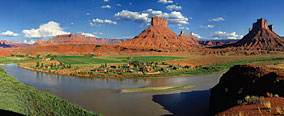
Original homesteaders settled the 160-acre ranch in 1903. Nearly a century later, Robbie and Hope Levin were searching for a special piece of land. As they drove through the dilapidated metal gate of the then-unnamed cattle ranch, they were struck by the unique setting and views.
They christened that land "Sorrel River Ranch" after being inspired by the color of the Colorado River when a spring rain turns the water red from the surrounding rocks, like the color of a sorrel horse.
LUXURY AND COMFORT
The ranch provides guest rooms and suites with a range of amenities. Guests can choose from river-view suites with fireplaces and jetted hydrotherapy tubs, or the monument- and mesa-view rooms and suites.Each suite is individually designed with log and rustic wood furniture combined with southwestern fabrics. Other highlights include large picture windows, private covered decks, overstuffed sofas, kitchenettes and dining areas, satellite TV, and the sound of the Colorado River. Year-round indoor comfort is provided by geothermal systems in the two 14,000-square-foot buildings where the guest suites are located.
After discussions with contractor Haining Heating and Refrigeration of Grand Junction, Colo., the Levins chose WaterFurnace geothermal units for the buildings. Had they not selected to use geothermal, the remote location of the resort would have required propane heating with outdoor fuel tanks and condensing units that could be noisy.
Haining's team, led by geothermal specialist Warren Oliver, worked with GeoSource Distributors to install four geothermal units in each building. Two 5-ton geothermal units serve four guest suites on the first floor; and two 3-ton geothermal units serve four guest suites on the second floor. Each E-Series dual-capacity geothermal unit is connected to an IntelliZone control system, allowing each suite to have its own thermostat.

"During our first meeting with Mr. Levin, I explained how the geothermal units would provide unmatched comfort for his guests while reducing his heating bills significantly compared to heating with propane," said Brian Fowler, owner of GeoSource Distributors. "Plus, his air conditioning costs would be reduced."
A horizontal closed-loop system was designed and installed to serve the geothermal units. Located in an adjacent pasture, the loop is comprised of 32 trenches 200-feet long, with 800 feet of pipe in each trench. This four-pipe design contains two circuits per trench and two layers of pipe. The geothermal units serving the downstairs suites have their own individual loops; the upstairs units share a common loop.
"Since we had adequate land in the pasture, a horizontal loop was the obvious choice and helped reduce the upfront cost compared to drilling vertical loops," said Fowler.
Because geothermal systems use the earth's ability to store heat, they operate at a fraction of the cost of ordinary heating and cooling systems, WaterFurnace officials said. For each unit of electricity used, they said a geothermal unit generates four to five units of equivalent heat energy.
RESULTS
The estimated savings per year are approximately $8,300. "We are experiencing 50- to 70-percent savings on our electric bills and with oil prices the way they are, the savings last winter on gas were huge," Levin said. "Obviously savings will be much larger in the future as the costs of fossil fuels continue to rise."Future expansion plans include the use of more geothermal systems.
For more information, visit www.waterfurnace.com
Publication date: 02/06/2006

Report Abusive Comment